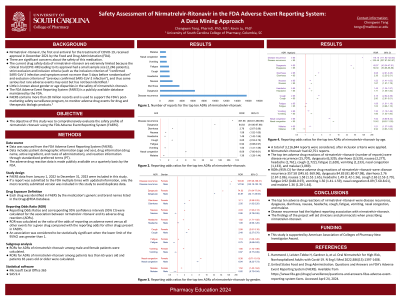(474) Safety Assessment of Nirmatrelvir-ritonavir in the FDA Adverse Event Reporting System: A Data Mining Approach


Chengwen Teng, Pharm.D., PhD, M.S.
Assistant Professor
University of South Carolina, United States- KL
Kevin Lu, Ph.D.
Associate Professor
University of South Carolina, United States
Primary Author(s)
Co-Author(s)
Objective : Nirmatrelvir-ritonavir, the first oral antiviral for the treatment of COVID-19, received approval in December 2021 by the Food and Drug Administration (FDA). However, there are potential concerns about the safety of this medication. The objective of this study was to comprehensively evaluate the safety profile of nirmatrelvir-ritonavir using the FDA Adverse Event Reporting System (FAERS).
Methods: FAERS reports from January 1, 2022 to December 31, 2023 were included in the study. Reporting Odds Ratios (RORs) and corresponding 95% confidence intervals (95%CI) for the association between nirmatrelvir-ritonavir and its top ten adverse drug reactions were calculated. An association was considered to be statistically significant when the lower limit of the 95%CI was greater than 1.
Results: A total of 3,116,844 reports were considered, after inclusion criteria were applied. Nirmatrelvir-ritonavir had 42,751 reports. The top ten adverse drug reactions of nirmatrelvir-ritonavir (number of reports) were disease recurrence (15,707), dysgeusia (6,329), diarrhoea (3,520), nausea (2,277), headache (1,761), cough (1,722), fatigue (1,628), vomiting (1,233), nasal congestion (1,133), and malaise (1,069). RORs (95% CI) for these adverse drug reactions of nirmatrelvir-ritonavir were: disease recurrence 357.58 (345.61-369.96), dysgeusia 84.83 (81.80-87.98), diarrhoea 2.76 (2.67-2.86), nausea 1.58 (1.52-1.65), headache 1.49 (1.42-1.56), cough 2.65 (2.53-2.79), fatigue 0.92 (0.88-0.97), vomiting 1.50 (1.41-1.59), nasal congestion 8.09 (7.60-8.61), and malaise 1.36 (1.28-1.44).
Conclusions: The top ten adverse drug reactions of nirmatrelvir-ritonavir were disease recurrence, dysgeusia, diarrhoea, nausea, headache, cough, fatigue, vomiting, nasal congestion, and malaise. Disease recurrence had the highest reporting association with nirmatrelvir-ritonavir. The findings of the project will aid clinicians and pharmacists when prescribing nirmatrelvir-ritonavir.
Methods: FAERS reports from January 1, 2022 to December 31, 2023 were included in the study. Reporting Odds Ratios (RORs) and corresponding 95% confidence intervals (95%CI) for the association between nirmatrelvir-ritonavir and its top ten adverse drug reactions were calculated. An association was considered to be statistically significant when the lower limit of the 95%CI was greater than 1.
Results: A total of 3,116,844 reports were considered, after inclusion criteria were applied. Nirmatrelvir-ritonavir had 42,751 reports. The top ten adverse drug reactions of nirmatrelvir-ritonavir (number of reports) were disease recurrence (15,707), dysgeusia (6,329), diarrhoea (3,520), nausea (2,277), headache (1,761), cough (1,722), fatigue (1,628), vomiting (1,233), nasal congestion (1,133), and malaise (1,069). RORs (95% CI) for these adverse drug reactions of nirmatrelvir-ritonavir were: disease recurrence 357.58 (345.61-369.96), dysgeusia 84.83 (81.80-87.98), diarrhoea 2.76 (2.67-2.86), nausea 1.58 (1.52-1.65), headache 1.49 (1.42-1.56), cough 2.65 (2.53-2.79), fatigue 0.92 (0.88-0.97), vomiting 1.50 (1.41-1.59), nasal congestion 8.09 (7.60-8.61), and malaise 1.36 (1.28-1.44).
Conclusions: The top ten adverse drug reactions of nirmatrelvir-ritonavir were disease recurrence, dysgeusia, diarrhoea, nausea, headache, cough, fatigue, vomiting, nasal congestion, and malaise. Disease recurrence had the highest reporting association with nirmatrelvir-ritonavir. The findings of the project will aid clinicians and pharmacists when prescribing nirmatrelvir-ritonavir.

.png)